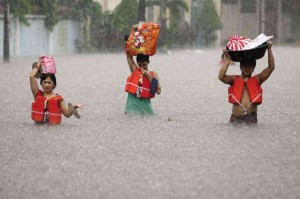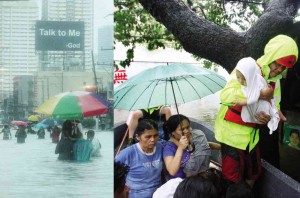‘Habagat lesson’ sends more to shelters

WITH life vests on and a few belongings in hand, residents of Barangay Sto. Domingo, Quezon City, wade through flood waters on their way to safer ground Tuesday, as parts of Metro Manila go underwater due to incessant rains for the past two days. MARIANNE BERMUDEZ
Safe and dry in the care of a local parish, Yolanda Angobang said she had learned her lesson.
“We did not take risks anymore. We were trapped on the roof of our house last time, when we were taken by surprise,” said the 48-year-old housewife from Barangay Sto. Domingo, Quezon City, recounting her family’s experience with habagat (southwest monsoon) last year.
“Now we have plenty of warning, although we only managed to take a few clothes,” Angobang said, waiting out the hours on carton boards that served as a mat for her family inside Sto. Domingo church, which that morning took in some 700 souls from the city’s danger zones.
Torrential rains induced by Tropical Storm “Maring” for the second straight day paralyzed Metro Manila and nearby areas Tuesday, sending more residents by the thousands to evacuation centers as flash floods spread across the capital.
Many evacuees interviewed by the INQUIRER said they avoided making the same mistakes— procrastination and postponing decisions to the last minute— when habagat last lashed the capital with such a fury.
Soring Dio, 53, who lives along Don Pepe Street also in Barangay Sto. Domingo, said she urged members of her family to flee to higher ground as early as 7 a.m. Tuesday when she noticed the rains weren’t stopping.
Four hours later, with her family already on safer ground, Don Pepe Street had become a river, with the flood reaching over seven feet. “It’s good that my housemates believed me,” she told the INQUIRER, a one-year-old child in her arms.
Quezon City Mayor Herbert Bautista said the habagat’s effects on the city were considerably mitigated by “lessons learned” from last year’s experience with monsoon rains.
“The barangays (villages) which were flooded had been identified as flood-prone. Most of the residents volunteered to evacuate when they noticed that the rain was not letting up,” he told the Inquirer.
Compared to last year’s figures, the number of barangays that required rescue boats was lower since hundreds of informal settler families (ISFs) living near waterways had already been relocated.
Quezon City Task Force Waterways chief Tadeo Palma said that as of Aug. 16, some 1,700 ISFs had been relocated from waterways and other danger zones, out of the total of more than 4,000 ISFs citywide.
As of 4:40 p.m. Tuesday, 4,933 families from 38 barangays were in 57 evacuation centers in Quezon City, after two creeks swelled and the Tullahan River neared overflowing before noon.

CALAMITY LIFELINES. A billboard sign aptly offers a message of solace for the weary souls crossing a flooded street in Makati’s central business district while help comes to a family found by rescuers in Barangay Sto. Domingo, Quezon City. GERRY JANO; MARIANNE BERMUDEZ/ INQUIRER
Dr. Noel Lansang, head of the Quezon City disaster risk reduction and management office, said floodwaters rose to up to five feet around 9 a.m. in barangays near Talayan and Gumamela creeks, which run along Araneta Avenue and the Roxas District, respectively, and are both tributaries of San Juan River.
Spillage from La Mesa Dam had also prompted residents in areas near the Tullahan River to voluntarily evacuate. The water line breached the dam’s spilling level of 80.15 meters around 11:20 a.m.
Also among the flooded areas in Quezon City were Novaliches, Fairview, Project 8, New Manila, and San Francisco del Monte, Bagong Silangan, Sto. Domingo, Sta. Cruz, Sta. Lucia, Masambong, Damayan, Apolonio Samson, Damayang Lagi, Doña Imelda, North Fairview, Gulod, Nagkaisang Nayon, and San Bartolome.
Forced evacuations
Forced evacuations were also carried out in other Metro cities.
Johnny Yu, officer in charge of the Manila Disaster Risk Reduction and Management Office, said at least 700 families had been moved from low-lying areas near San Juan River, Pasig River and Manila Bay.
The Baseco Evacuation Center was filled to capacity with about 600 families, forcing authorities to move others to the nearby President Cory C. Aquino High School. Residents from Parola Compound and Isla Puting Bato were evacuated to the Delpan Evacuation Center.
Chest-deep floodwaters submerged the Sta. Mesa area near Manila’s boundary with San Juan City, where evacuees taking shelter in barangay halls had to stay on the second floor.
The flood rendered 80 percent of Manila’s roads impassable to light vehicles, Yu added.
Water level in Marikina River rose to 18 meters, setting off an evacuation protocol that sent about 1,000 families to Marikina City campuses and covered basketball courts. The local government starts alerting residents when the water level reaches 15 meters.
In San Juan City, the San Juan River reached 13.71 meters as of 11 a.m., 1.71 meters higher than the normal level.
As of early afternoon, 186 families were staying at the San Juan Gym; 15 families at a community center in Barangay Progreso; nine families in Barangay Maytunas; and 10 families in Barangay Salapan.
The affected residents in Salapan were among the more than 50 families who were already preparing to be relocated to Bulacan province, in line with a national government initiative to clear waterways of shanties, village chair Patrocinio dela Cruz said.
In Pasig City, eight families or 44 individuals were evacuated to Nagpayong covered court in Barangay Pinagbuhatan.
In Pateros, the flood spread to all of its 10 barangays, forcing 3,000 people to leave their homes and take shelter in 13 evacuation centers. The water was chest-high in the low-lying areas and the town’s two major roads—C. Almeda and Martires Streets—were also left impassable to vehicles.
Pateros Mayor Joey Medina said the municipal council on Tuesday afternoon issued a resolution declaring a state of calamity.
Worse than ‘Ondoy’
In her 20 years living along the creekside in Barangay San Antonio, Parañaque City, Nimfa Castro had never experienced flooding as bad as in the past three days.
“I’ve always wished to be relocated! Even if we’re taken to another province. We are ready to leave [the creekside],” said the mother of one.
She said her family was spared the brunt of “Ondoy” in 2009 and of last year’s monsoon rains. But since Sunday, two houses in her neighborhood on Sta. Scholastica street have been swept away by the rushing waters.
The second floor her family had built in the aftermath of Ondoy proved useless. “When the water started going up the stairs, we knew we had to get out,” she said when the INQUIRER saw her at San Antonio sports complex, which was housing at least 55 families.
Parañaque City Hall said a total of 4,418 families had fled their flooded homes as of Tuesday afternoon, prompting officials to declare a state of calamity.
In Las Piñas City, some 1,350 families were evacuated. Muntinlupa City also declared a state of calamity, with 7,650 families affected by the flood.
The lakeshore city of Taguig had 2,216 families moving to 26 evacuation centers.
In flood-prone Malabon City, rescuers came to the aid of 5,000 residents, mostly along Tullahan River, while 21 out of Valenzuela’s 31 barangays went underwater. With reports from Erika Sauler, Niña P. Calleja, Julie Aurelio, and Nathan Melican














